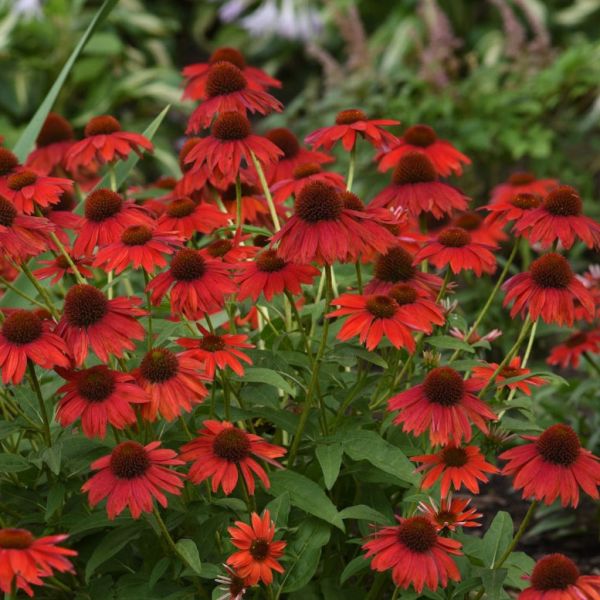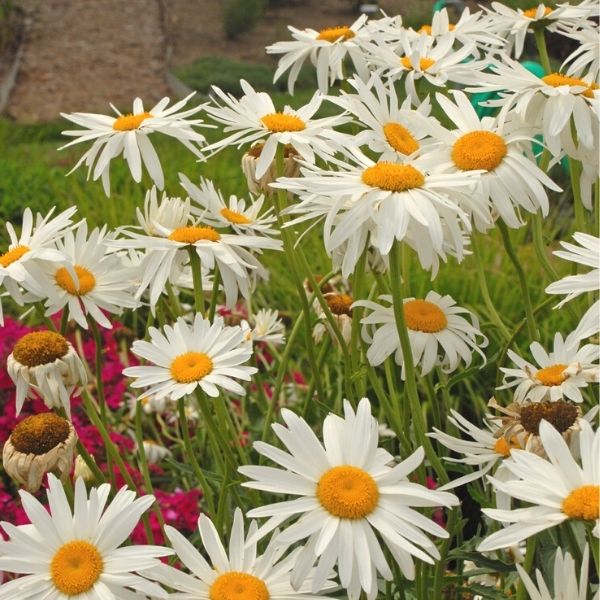

Purple Coneflower
Echinacea purpurea
19 reviews
Purple Coneflower
Echinacea purpurea
19 reviews
- Easy to grow and low maintenance
- Attracts butterflies, bees, and other pollinators
- Beautiful, long-lasting blooms in shades of purple and pink
- Recommended by landscape designers for optimal fit in real yards
$47.00
$68.00
30% Off
- Ships to 43215 in 3 to 7 days
- Free Shipping Over $150
- Plant Arrival Guarantee
- In Stock
- Free Plant Consult
$200 - Landscape-Approved: Every Plant We Sell Comes With Design Expertise Behind It
1 Gallon
Not just beautiful - intentionally selected by ShrubHub's 3D landscape design team to fit real-world spaces and maximize yard potential.
Why Purple Coneflower?
Purple Coneflower is a native wildflower species that belongs to the Asteraceae family. It is mostly found in North America and is widely cultivated in gardens due to its colorful and attractive flowerheads. The plant has traditional medicinal uses that include boosting the immune system, treating colds and flu, and reducing inflammation. Coneflower is also a valuable addition to pollinator gardens due to its nectar and pollen-rich flowers.
People who loved this plant also bought
Sunlight
Purple Coneflower (Echinacea purpurea) requires full sun, meaning it needs at least 6-8 hours of direct sunlight per day. It is a sun-loving plant that thrives in bright, sunny locations and may not perform as well in shaded areas.
Watering
The watering requirement for Purple Coneflower is moderate to low. It is a drought-tolerant plant that is able to withstand dry conditions, making it suitable for areas with limited water availability.
Fertilizing
Purple Coneflower (Echinacea purpurea) does not have any specific fertilizer requirement. However, a balanced, slow-release fertilizer high in nitrogen can be applied in early spring to promote healthy growth. it is always recommended to conduct a soil tes
This vibrant shrub will work magic in your garden, transforming it into a vibrant tapestry, where hues of purple paint a portrait of beauty that resonates with the charm of the wild.
Welcome the Purple Coneflower, a botanical gem that infuses your outdoor haven with the essence of nature's allure. Let its radiant blooms take you on a journey through a garden of splendor.
With stunning blooms that mirror the untamed beauty of a meadow, with petals in shades of rich purple that nod to the simple elegance of nature's palette. The Purple Coneflower's blooms sway in harmony with the wind, evoking the feeling of wandering through a field of wildflowers on a sun-kissed day.
The colorful coneflower is a true burst of life in your garden. Imagine a chorus of blooms that stand tall like joyful sentinels, each one contributing to your garden's symphony of color. It's like having your private wildflower meadow, a haven for pollinators and a feast for the eyes.
The Purple Coneflower’s charms don’t end there, it's also a delightful retreat for delicate visitors like butterflies and bees. Its nectar-rich blooms become a haven for these enchanting creatures, turning your garden into a vibrant gathering place for nature's most graceful performers.
Whether you're a seasoned gardener or just beginning your green journey, the Purple Coneflower offers effortless beauty that captures hearts. It thrives in a variety of conditions, from full sun to partial shade, making it a versatile addition to any garden. With minimal care, you'll be rewarded with a parade of captivating purple blooms.
Plant Information:
| Botanical Name: | Echinacea purpurea |
| USDA Zones: | 3 - 8 |
| Water: | Low Once Established |
| Exposure: | Full Sun |
| Soil Needs: | Well Drained |
| Mature Height: | 2 - 5 feet |
| Mature Spread: | 18 - 24 inches |







Pollination Info
Pollination Information for Purple Coneflower (Echinacea purpurea)
Purple coneflower is a popular garden plant that is also found in the wild in North America. The plant produces attractive purple or pink flowers that attract a variety of pollinators. Here is some detailed pollination information for purple coneflower:
Pollinator Types
- Bees - Both honey bees and native bees are attracted to the nectar and pollen of purple coneflower. They are the most important pollinators of the plant.
- Butterflies - Many species of butterflies, including monarchs, visit purple coneflower to sip nectar.
- Moths - Some moths are attracted to the flowers at night.
- Hummingbirds - These birds are attracted to the bright colored flowers and sip nectar while hovering in front of the blossom.
Pollination Process
Purple coneflowers produce both nectar and pollen, which are located at the base of the flower head. When a pollinator lands on the flower head, its body brushes against the anthers, which contain the pollen. Some of the pollen sticks to the pollinator's body and is carried to the next flower. In the process of collecting nectar, the pollinator's body also brushes against the stigma, which is where the pollen needs to be deposited in order to fertilize the flower.
Benefits of Pollination
Pollination is important for the reproduction of purple coneflower and other plants. When a flower is successfully pollinated, it will produce seeds that can be dispersed and grow into new plants. This benefits both the plant and the ecosystem it belongs to, providing food and habitat for other wildlife.
FAQ
Purple Coneflower (Echinacea purpurea) FAQ
What is Purple Coneflower?
Purple Coneflower (Echinacea purpurea) is a perennial wildflower that is native to North America. It is also known as Eastern Purple Coneflower, Hedgehog Coneflower or Purple Coneflower. It has showy purple petals with a distinctive cone-shaped center and long stems that can grow up to 4 feet tall.
What are the growing conditions for Purple Coneflower?
Purple Coneflower prefers to grow in well-drained soils and full sun, although it can also tolerate light shade. It is a drought-tolerant species that can thrive in very dry climates. It is hardy in USDA zones 3-9.
How do I plant Purple Coneflower?
Purple Coneflower can be planted in early spring or fall. Seeds should be sown directly into the soil about 1/4 inch deep, then lightly watered. When planting seeds, it is important to choose a sunny location and well-drained soil. Established plants can also be divided in early spring or fall.
How do I care for Purple Coneflower?
Purple Coneflower needs little care once established. Watering is necessary only during prolonged periods of drought. Deadheading (removing spent blooms) will help extend the blooming period and prevent self-seeding. Cut back the foliage to the ground in late fall or early winter to prevent the plant from becoming invasive.
What are the uses of Purple Coneflower?
Purple Coneflower has a long history of medicinal use by Native American tribes. It is thought to stimulate the immune system and has been used to treat a variety of ailments including colds, flu, infections, and inflammation. In addition to its medicinal properties, Purple Coneflower is also a popular ornamental plant, attracting bees and butterflies to the garden.
Are there any pests or diseases that affect Purple Coneflower?
Purple Coneflower is relatively disease-free and resistant to pests. However, it can be susceptible to root rot if planted in poorly drained soil. Additionally, leaf spot and powdery mildew can occasionally affect the foliage of the plant.
How do I propagate Purple Coneflower?
Purple Coneflower can be propagated by seeds or by root division. Seeds can be collected from the mature heads and sown directly on the ground as described earlier. Root division involves digging up the plant and separating the root clumps into several smaller sections, then replanting those sections.
Planting & Care
Planting & Care for Purple Coneflower (Echinacea purpurea)
Planting:
- Choose a location with full sun to partial shade and well-drained soil.
- Plant seeds in the spring or fall, about 1/4 inch deep.
- Space plants about 18-24 inches apart.
- Water thoroughly after planting.
Care:
- Water regularly, especially during hot, dry weather.
- Deadhead spent blooms to encourage more flowering.
- Divide plants every 3-4 years to prevent overcrowding.
- Fertilize with a balanced fertilizer once a year.
- Watch for pests such as aphids, spider mites, and Japanese beetles.
- For natural pest control, plant companion plants such as marigolds, yarrow, and sage.
Benefits:
- Purple Coneflower is a tough, drought-tolerant perennial that attracts pollinators such as bees and butterflies.
- The plant is also known for its medicinal properties and is used in natural remedies for colds, flu, and other ailments.
- The flowers can be cut and used in arrangements or dried for later use.
Check Out These Verified Customer Reviews:
Customer Reviews
4.6 out of 5 based on 19 reviews
Thank you! Your review has been submitted.
Vibrant blooms, very pleased.
Arrived in perfect condition.
Beautiful purple color.
Item has been added to your cart.





















